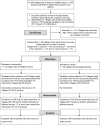Effect of a School-Based Hygiene Behavior Change Campaign on Handwashing with Soap in Bihar, India: Cluster-Randomized Trial
- PMID: 30105966
- PMCID: PMC6159589
- DOI: 10.4269/ajtmh.18-0187
Effect of a School-Based Hygiene Behavior Change Campaign on Handwashing with Soap in Bihar, India: Cluster-Randomized Trial
Abstract
Changing hand hygiene behavior at scale in the community remains a challenge. The objective of this study was to estimate the effect of Unilever's school-based "School of 5" handwashing campaign on handwashing with soap (HWWS) in schoolchildren and their mothers in the Indian state of Bihar. We conducted a cluster-randomized trial in two districts. We randomized a total of 32 villages with at least one eligible school to intervention and control groups (1:1) and recruited 338 households in each group for outcome measurement. We used structured observation in households to measure HWWS at target occasions (after defecation, soap use during bathing, and before each main meal) in schoolchildren and their mothers. Observers were blinded to intervention status. We observed 636 target occasions (297 in the intervention arm and 339 in the control arm) in mothers and school-going children. After the intervention, HWWS prevalence at target occasions was 22.4% in the control arm and 26.6% in the intervention arm (prevalence difference +4.4%, 95% confidence interval: -4.0, 12.8). The difference was similar in children and mothers. Observers appeared to be adequately blinded to intervention status, whereas observed households were successfully kept unaware of the purpose of observations. To conclude, we found no evidence for a health-relevant effect of the School of 5 intervention on HWWS in schoolchildren and their mothers. Qualitative research suggested that reasons for the low impact of the intervention included low campaign intensity, ineffective delivery, and a model possibly not well tailored to these challenging physical and social environments.
Figures


Similar articles
-
The effect of a soap promotion and hygiene education campaign on handwashing behaviour in rural India: a cluster randomised trial.Trop Med Int Health. 2009 Oct;14(10):1303-14. doi: 10.1111/j.1365-3156.2009.02373.x. Epub 2009 Aug 25. Trop Med Int Health. 2009. PMID: 19708896 Clinical Trial.
-
Comparison of structured observation and pictorial 24 h recall of household activities to measure the prevalence of handwashing with soap in the community.Int J Environ Health Res. 2019 Feb;29(1):71-81. doi: 10.1080/09603123.2018.1511772. Epub 2018 Aug 27. Int J Environ Health Res. 2019. PMID: 30146894 Clinical Trial.
-
Teaching handwashing with soap for schoolchildren in a multi-ethnic population in northern rural Vietnam.Glob Health Action. 2013 Apr 24;6:1-12. doi: 10.3402/gha.v6i0.20288. Glob Health Action. 2013. PMID: 23618342 Free PMC article.
-
Handwashing with soap after potential faecal contact: global, regional and country estimates.Int J Epidemiol. 2019 Aug 1;48(4):1204-1218. doi: 10.1093/ije/dyy253. Int J Epidemiol. 2019. PMID: 30535198 Free PMC article.
-
Planned, motivated and habitual hygiene behaviour: an eleven country review.Health Educ Res. 2009 Aug;24(4):655-73. doi: 10.1093/her/cyp002. Epub 2009 Mar 13. Health Educ Res. 2009. PMID: 19286894 Free PMC article. Review.
Cited by
-
Improving young children's handwashing behaviour and understanding of germs: The impact of A Germ's Journey educational resources in schools and public spaces.PLoS One. 2020 Nov 23;15(11):e0242134. doi: 10.1371/journal.pone.0242134. eCollection 2020. PLoS One. 2020. PMID: 33227004 Free PMC article.
-
Nudge strategies for behavior-based prevention and control of neglected tropical diseases: A scoping review and ethical assessment.PLoS Negl Trop Dis. 2021 Nov 1;15(11):e0009239. doi: 10.1371/journal.pntd.0009239. eCollection 2021 Nov. PLoS Negl Trop Dis. 2021. PMID: 34723983 Free PMC article.
-
The potential of school-based WASH programming to support children as agents of change in rural Zambian households.BMC Public Health. 2021 Oct 8;21(1):1812. doi: 10.1186/s12889-021-11824-3. BMC Public Health. 2021. PMID: 34625029 Free PMC article.
-
Risk reduction of diarrhea and respiratory infections following a community health education program - a facility-based case-control study in rural parts of Kenya.BMC Public Health. 2020 Apr 29;20(1):586. doi: 10.1186/s12889-020-08728-z. BMC Public Health. 2020. PMID: 32349712 Free PMC article.
-
Cluster-randomised trial to test the effect of a behaviour change intervention on toilet use in rural India: results and methodological considerations.BMC Public Health. 2020 Sep 11;20(1):1389. doi: 10.1186/s12889-020-09501-y. BMC Public Health. 2020. PMID: 32917160 Free PMC article. Clinical Trial.
References
-
- Ejemot RI, Ehiri JE, Meremikwu MM, Critchley JA, 2008. Hand washing for preventing diarrhoea. Cochrane Database Syst Rev CD004265. - PubMed
-
- Cowling BJ, et al. 2009. Facemasks and hand hygiene to prevent influenza transmission in households: a cluster randomized trial. Ann Intern Med 151: 437–446. - PubMed
-
- Emerson PM, Cairncross S, Bailey RL, Mabey DC, 2000. Review of the evidence base for the ‘F’ and ‘E’ components of the SAFE strategy for trachoma control. Trop Med Int Health 5: 515–527. - PubMed
Publication types
MeSH terms
Substances
LinkOut - more resources
Full Text Sources
Other Literature Sources

